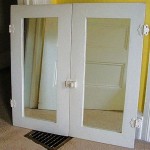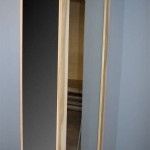Polished Metal Mirrors
Polished metal mirrors represent a significant stage in the historical development of reflective surfaces. Predating the widespread use of glass mirrors, they served various practical and ornamental purposes across different cultures. Their construction, properties, and eventual decline in popularity provide insight into the evolving technology of mirror making.
The earliest examples of polished metal mirrors date back to antiquity. Civilizations in Mesopotamia, Egypt, and the Indus Valley utilized readily available metals like copper, bronze, and speculum metal (an alloy of copper and tin) to create reflective surfaces. The process involved painstakingly hammering and polishing the metal to a high sheen. This labor-intensive process resulted in relatively small mirrors, often with a slightly convex surface due to the hammering technique.
The reflectivity of these early metal mirrors was considerably lower than modern glass mirrors. The surface imperfections inherent in the metal and the limitations of the polishing techniques prevented the achievement of a truly flawless reflection. Nonetheless, these mirrors were valuable tools for personal grooming, religious rituals, and signaling.
In ancient Egypt, polished metal mirrors held both practical and symbolic significance. They were essential grooming tools, and archaeological discoveries reveal numerous examples buried with the deceased, suggesting a belief in their continued utility in the afterlife. The Egyptians also incorporated polished metal mirrors into religious ceremonies, associating them with the sun god Ra and the concept of rebirth.
The use of polished metal mirrors spread throughout the ancient world. The Romans, Greeks, and Etruscans adopted and further developed the technology, incorporating mirrors into everyday life and artistic expression. Mirrors frequently appear in Roman frescoes and mosaics, reflecting the importance of personal appearance and the growing availability of these objects.
During the medieval period, polished metal mirrors continued to be valued possessions. The development of new alloys and improved polishing techniques resulted in mirrors with higher reflectivity. However, the production process remained labor-intensive, and metal mirrors were generally reserved for the wealthy elite. They served not only practical purposes but also as symbols of status and power.
The introduction of glass mirrors with a metallic backing in the late Middle Ages and Renaissance marked a significant turning point. The Venetian glassmakers pioneered the technique of coating glass with a thin layer of silver, mercury, or tin amalgam, resulting in a much brighter and clearer reflection than achievable with polished metal. These glass mirrors were also less susceptible to corrosion and easier to produce in larger sizes.
The rise of glass mirrors gradually led to the decline of polished metal mirrors. While metal mirrors retained a niche application in specific contexts, particularly scientific instruments like telescopes, glass mirrors became the dominant form of reflective surface for everyday use.
The properties of polished metal mirrors differ significantly from their glass counterparts. Metal mirrors reflect light through the interaction of photons with the free electrons in the metal surface. This interaction results in a slightly different reflection mechanism compared to the dielectric interface reflection that occurs in glass mirrors with a metallic backing. This difference can lead to subtle variations in the color and intensity of the reflected light.
Another key difference lies in the durability and susceptibility to environmental factors. Polished metal mirrors are prone to oxidation and tarnishing, especially in humid environments. Regular polishing is often required to maintain their reflectivity. Glass mirrors, on the other hand, are generally more resistant to these effects, although the metallic backing can still deteriorate over time.
Despite being largely superseded by glass mirrors, polished metal mirrors retain historical and scientific significance. They represent a crucial stage in the evolution of reflective technology and provide valuable insights into the material culture of ancient civilizations. Furthermore, the unique reflective properties of polished metal continue to find applications in specialized optical instruments and scientific research.
The study of polished metal mirrors offers a fascinating glimpse into the ingenuity of past cultures and the ongoing quest for improved reflective surfaces. From the rudimentary copper mirrors of ancient Mesopotamia to the precisely crafted speculum metal mirrors of later centuries, these objects reflect the technological advancements and aesthetic sensibilities of their time.

Mirror Polished Stainless Steel Fabweld Metalworks

Mirror Polished Stainless Steel Sheets High Gloss Finish

Mirror Polished Stainless Steel Sheets High Gloss Finish

Mirror Polished Stainless Steel Sheet Artist Choice International Metal Limited

Mirror Polished Stainless Steel Lumenautica

Contemporary Polished Metal Wall Mirror Oval Silver Framed Hamilton Hills

Mirror Polished Stainless Steel Sheets High Gloss Finish

Mirror Finish Norton Abrasives

Stainless Steel Mirror Polish Sheet Of High Quality 0 1mm To 6mm At Rs 300 Kg In Mumbai

2024 Mirror Polished Modern Metal Sculpture In Stainless Steel For Decor Youfine








